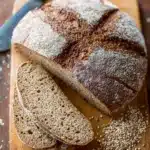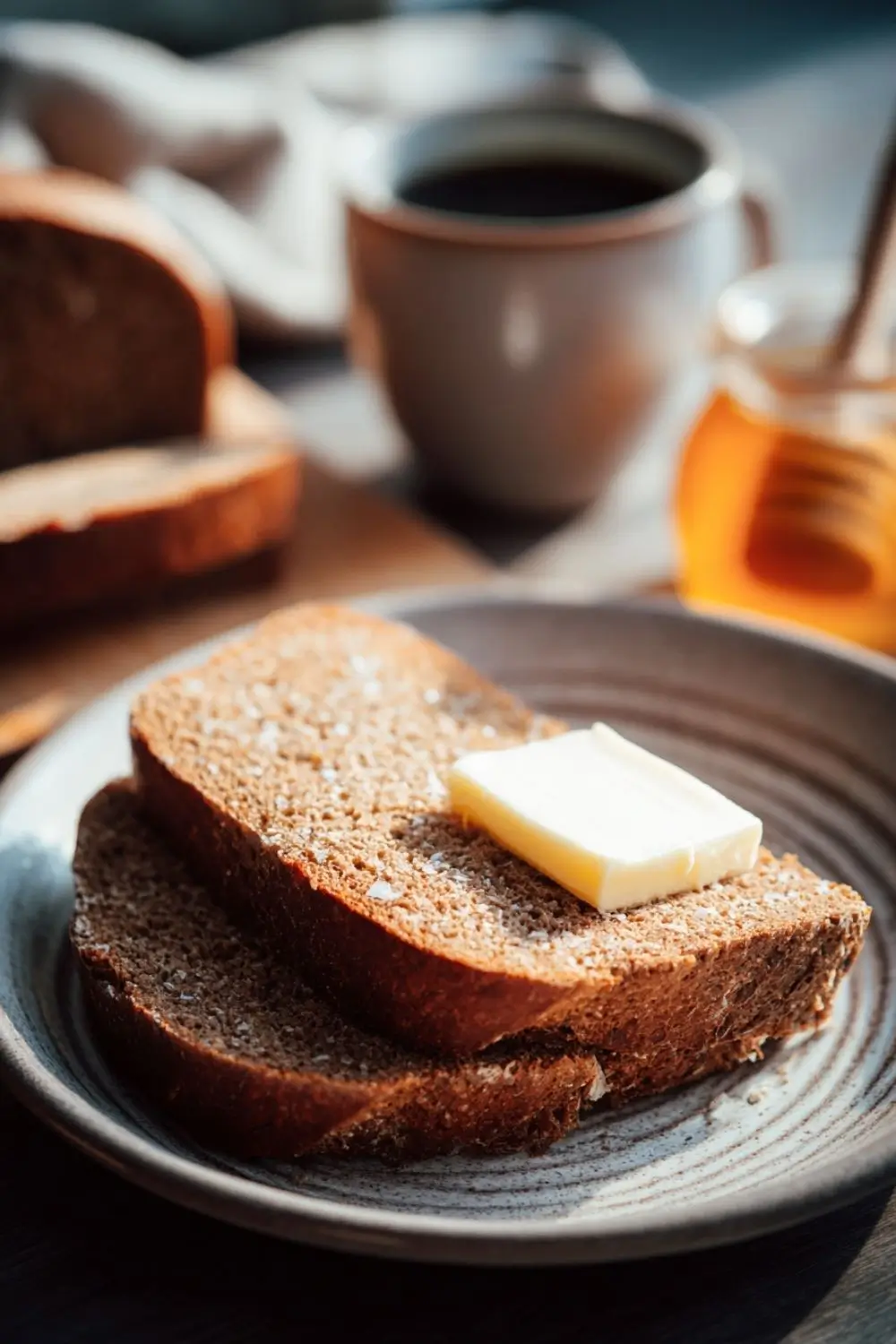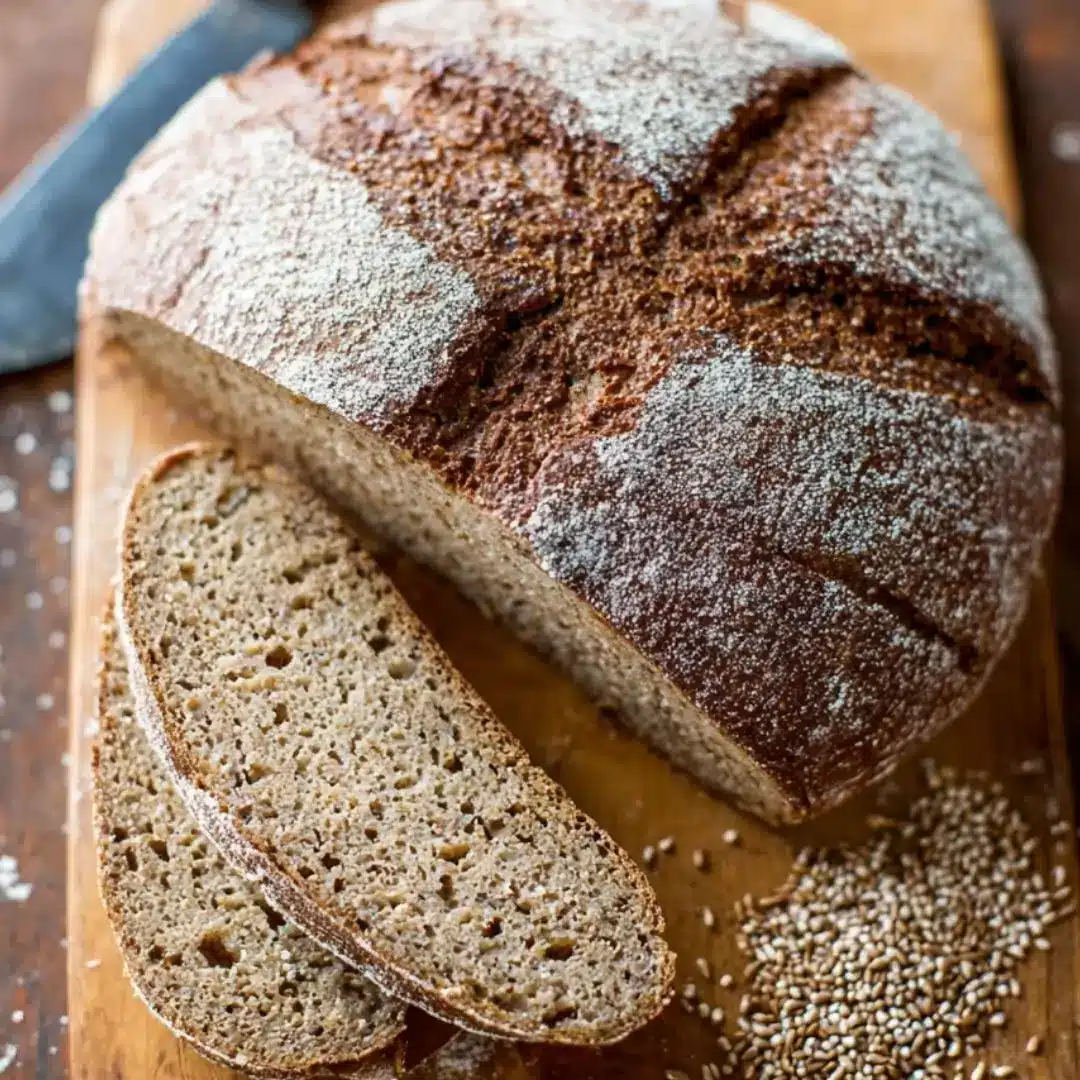There’s something deeply nostalgic about the aroma of fresh rye bread baking in the oven. But when gluten is off the table, finding that familiar flavor can feel impossible until now. This rye gluten free bread recipe brings back the hearty comfort of traditional loaves without a trace of wheat.
Whether you’re craving a sourdough style crust or want the ease of a bread machine, you’ll find a wholesome, husband approved recipe below.
Each slice is a quiet thank you a love letter baked into bread. Let’s bring warmth back to your kitchen, one gluten free loaf at a time.
Table of Contents:
Table of Contents

Rye Gluten Free Bread Recipe (Comfort in Every Slice)
- Prep Time: 20 minutes
- Cook Time: 50 minutes
- Total Time: 1 hour 10 minutes
- Yield: 1 loaf 1x
- Category: Bread
- Method: Baking
- Cuisine: Gluten-Free
Description
A deeply flavorful gluten free rye bread recipe made with buckwheat, teff, and caraway seeds. Includes sourdough and bread machine versions.
Ingredients
1 cup buckwheat flour
¾ cup teff flour
½ cup sorghum flour
¼ cup tapioca starch
2 tablespoons psyllium husk
1 tablespoon caraway seeds
1 tablespoon cocoa powder
1 teaspoon salt
2 tablespoons olive oil
1 tablespoon molasses
1 tablespoon apple cider vinegar
1¼ cups warm water
1 cup gluten-free sourdough starter
Instructions
1. Combine all dry ingredients in a large bowl.
2. In another bowl, mix olive oil, molasses, vinegar, water, and sourdough starter.
3. Stir wet ingredients into dry to form a thick dough. Add extra water if too dry.
4. Cover and let rise in a warm place for 6–8 hours.
5. Shape dough and place into parchment-lined bread pan.
6. Let rest for 30–45 minutes while oven preheats to 425°F.
7. Bake for 45–50 minutes until deep brown and hollow-sounding.
8. Cool completely on a rack before slicing.
Notes
Use psyllium husk for best texture and crumb.
Cocoa powder adds richness and deep color without sweetness.
For bread machine version, add wet first, then dry, and yeast last.
Nutrition
- Serving Size: 1 slice
- Calories: 180
- Sugar: 1g
- Sodium: 190mg
- Fat: 5g
- Saturated Fat: 0.5g
- Unsaturated Fat: 4.5g
- Trans Fat: 0g
- Carbohydrates: 30g
- Fiber: 4g
- Protein: 4g
- Cholesterol: 0mg
My Story Behind This Rye Gluten Free Bread Recipe
Why I Needed a Recipe Gluten Free Rye Bread

My husband has always had a soft spot for old fashioned rye bread the kind with a chewy crust, deep earthy flavor, and caraway seeds that linger on your tongue. He used to say it reminded him of sitting in his grandfather’s kitchen with a warm bowl of soup and a thick buttered slice.
When we discovered he needed to go gluten-free, one of the first things he mourned was that rye bread. That’s when I made it my mission to find the perfect recipe gluten free rye bread that would bring him back to that feeling without the gluten.
What I learned early on is that a traditional rye bread is made with rye flour, which contains gluten. So creating a gluten free rye bread recipe wasn’t just about substitution it was about intention.
What Makes This Recipe Unique
Unlike most gluten-free loaves that lean bland or crumbly, this one holds together beautifully and tastes like the real thing. Instead of rye flour, I use buckwheat and teff flours to build a bold, hearty flavor base. A touch of cocoa powder gives it richness, while apple cider vinegar and molasses offer depth and color. And those essential caraway seeds? They’re still right where they belong.
This rye gluten free bread recipe became more than just something we eat it became a weekend ritual. I bake while he reads the paper. We slice it warm. And together, we remember the old rye grateful we’ve found a new one that loves him back.
And just like how I reimagined his favorite bread, I’ve done the same with desserts he used to miss like this Vegan Gluten-Free Almond Cake Recipe that’s just as tender as any bakery slice, or this Gluten-Free Carrot Cake Recipe that we now save for birthdays and quiet Sunday afternoons.
Gluten Free Sourdough Rye Bread Recipe
Ingredients (Gluten Free Sourdough Rye Style)
To mimic the tangy, rich profile of rye bread without gluten, this sourdough version uses a carefully blended mix of hearty, flavorful flours. Here’s everything you need for one medium loaf:

- 1 cup buckwheat flour
- ¾ cup teff flour
- ½ cup sorghum flour
- ¼ cup tapioca starch
- 2 tablespoons psyllium husk
- 1 tablespoon caraway seeds
- 1 tablespoon cocoa powder (unsweetened)
- 1 teaspoon salt
- 2 tablespoons olive oil
- 1 tablespoon molasses
- 1 tablespoon apple cider vinegar
- 1¼ cup warm water (plus more if needed)
- 1 cup gluten-free sourdough starter (active and bubbly)
This mix gives your bread a deep, dark color and that signature chew without a crumb of wheat or rye. If you’re new to using gluten free flours, I recommend trying similar textures in this Gluten-Free Red Velvet Cake Recipe another treat that balances richness with softness.
Instructions (Gluten Free Sourdough Rye Style)
- In a large bowl, combine all dry ingredients: buckwheat flour, teff, sorghum, tapioca starch, psyllium husk, caraway seeds, cocoa powder, and salt.
- In a separate bowl, mix the wet ingredients: olive oil, molasses, apple cider vinegar, warm water, and your bubbly gluten-free sourdough starter.
- Slowly pour the wet mixture into the dry and stir with a spatula until a thick dough forms. If it’s too dry, add another tablespoon or two of warm water.
- Cover the dough and let it rise in a warm place for 6–8 hours. A warm oven (turned off) works beautifully.
- After rising, shape the dough into a ball and place it into a parchment-lined bread pan or proofing basket. Let it rest for 30–45 minutes.
- Preheat your oven to 425°F (220°C).
- Bake for 45–50 minutes or until the crust is deep brown and the loaf sounds hollow when tapped.
- Cool completely before slicing.
The sourdough starter gives this gluten free rye bread recipe its classic tang and texture—while ingredients like psyllium husk mimic gluten’s binding powers. It’s a deeply nourishing, husband-approved bread you’ll want to make again and again.
And if you’re in the mood for something sweet after baking, try the light, airy Gluten-Free Angel Food Cake Recipe it’s a perfect contrast to the hearty loaf you just made.
Gluten Free Rye Bread Recipe for Bread Machine
Ingredients (Bread Machine Friendly)
If you’re looking for a low fuss way to recreate the hearty comfort of traditional rye, this bread machine recipe is for you. It’s soft, flavorful, and slices beautifully perfect for toast, sandwiches, or a warm pat of butter.
Here’s what you’ll need:
- 1 cup millet flour
- 1 cup brown rice flour
- ½ cup tapioca starch
- 2 tablespoons ground flaxseed
- 1 tablespoon psyllium husk
- 1 tablespoon caraway seeds
- 1 tablespoon cocoa powder
- 1 teaspoon salt
- 1 tablespoon molasses
- 1 tablespoon olive oil
- 1 tablespoon apple cider vinegar
- 1¼ cups warm water
- 2 teaspoons active dry yeast
- Optional: 1 teaspoon maple syrup (for a hint of sweetness)
These ingredients are balanced for texture and depth perfect for replicating that rye-like flavor in a gluten free way. If you’re exploring baked treats beyond bread, you might enjoy the soft texture of this Gluten-Free Ice Cream Cake Recipe too.
Instructions (Bread Machine Friendly)

- Add the wet ingredients to the bread machine pan in this order: warm water, molasses, olive oil, and apple cider vinegar.
- In a separate bowl, whisk together the millet flour, brown rice flour, tapioca starch, flaxseed, psyllium husk, cocoa powder, salt, and caraway seeds.
- Gently spoon the dry mix over the wet ingredients in the pan don’t stir.
- Create a small well in the center of the dry mix and add the yeast.
- Select your machine’s “Gluten-Free” or “Basic” cycle. If available, choose a medium crust setting.
- Start the machine. Once it’s done baking (about 2.5–3 hours total), let the bread sit for 10 minutes before removing it from the pan.
- Cool completely on a wire rack before slicing.
This machine-friendly version of the gluten free rye bread recipe is a weeknight hero. No kneading. No fuss. Just comfort.
Pair it with a warm drink, and if you’re feeling festive, follow it with something like this Gluten-Free Carrot Cake Recipe for dessert. It’s the perfect balance of earthy and sweet.
Mastering the Perfect Gluten Free Rye-Style Bread
Tricks for Better Rise and Texture
If there’s one thing I’ve learned while perfecting a gluten free rye bread recipe, it’s this: gluten-free baking isn’t about replacing it’s about rebuilding. Without gluten, bread needs extra support, both in structure and flavor. Here’s how I do it.
Use psyllium husk or ground flaxseed as your foundation. These ingredients act like a gentle net that traps moisture and mimics gluten’s elasticity. A tablespoon or two will transform your dough from fragile to beautifully workable.
Next, let the dough hydrate fully. Unlike wheat dough, gluten-free dough benefits from a longer resting period after mixing. Letting it sit for 20–30 minutes before proofing gives the flours time to absorb moisture and bind together. This step makes all the difference in crumb and rise.
And finally, don’t skip the apple cider vinegar. A touch of acid strengthens your dough and adds the kind of gentle tang you’d expect from rye sourdough.
Once you nail the rhythm, this bread becomes second nature—just like my go-to Gluten-Free Red Velvet Cake Recipe that never fails to impress.
Common Pitfalls to Avoid
Even with a perfect recipe, small missteps can lead to dense or gummy bread. Here are the most common things to avoid:
- Using real rye flour: While it sounds counterintuitive, rye contains gluten. Stick to substitutes like buckwheat or teff for a safe and delicious loaf.
- Overmixing: Gluten-free doughs don’t need kneading. Stir just until combined, then let it rest.
- Skipping the rest period: This allows the flours to absorb moisture and form structure naturally.
- Cold proofing too long: While sourdough benefits from a cold rise, gluten-free dough can dry out. Keep it between 75–85°F for the best texture.
Because love, after all, is in every bite we share, I make something simple and sweet like this light as air Vegan Gluten-Free Almond Cake Recipe.
Conclusion rye gluten free bread recipe

When I bake this gluten free rye bread, I’m not just recreating a food my husband once loved I’m honoring the bond we’ve built through every change, every choice.
This loaf, like so many of our shared meals, is a quiet thank you. For standing by me. For trusting my hands in the kitchen. And for loving bread enough to miss it.
And when you’re ready for dessert, don’t miss the soft simplicity of this Gluten-Free Ice Cream Cake. Love always has room for something sweet.
Frequently Asked Questions: rye gluten free bread recipe
Can rye bread be gluten-free?
Traditional rye bread contains gluten because rye is a gluten-containing grain. However, a gluten-free rye bread is possible by using alternative flours like buckwheat, teff, and sorghum. Recipes like the one above use caraway seeds and molasses to recreate that rich “rye-like” flavor without the actual rye.
What is the trick to making good gluten-free bread?
The secret lies in moisture, structure, and balance. Use psyllium husk or flax to bind your dough, and allow for proper hydration before baking. Don’t overmix or rush the resting time. Acidic ingredients like apple cider vinegar also help improve rise and texture.
What ingredients to avoid in gluten-free bread?
Avoid any wheat-based flours, as well as rye, barley, and spelt. Steer clear of malt flavorings and certain processed ingredients that may contain hidden gluten. Always check labels, even on baking powder and yeast.
What is the best flour for gluten-free bread making?
It depends on the flavor and texture you’re after. For a “rye-style” bread, buckwheat and teff offer depth, while tapioca starch and sorghum improve lightness and elasticity. Combining multiple flours often yields the best results.

